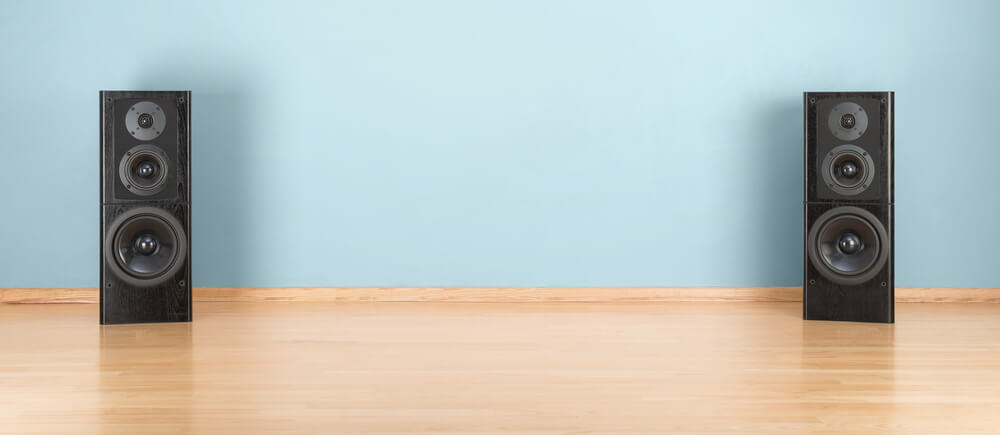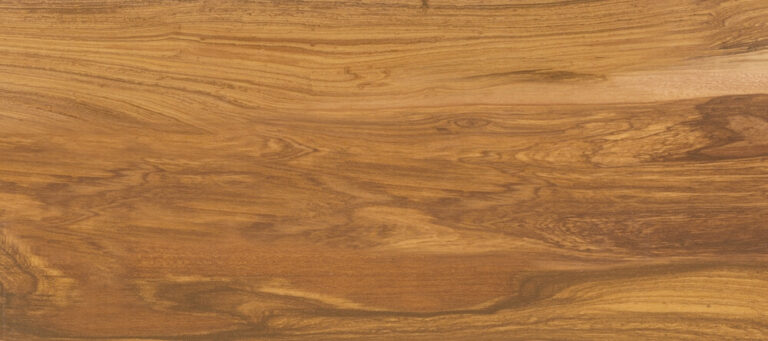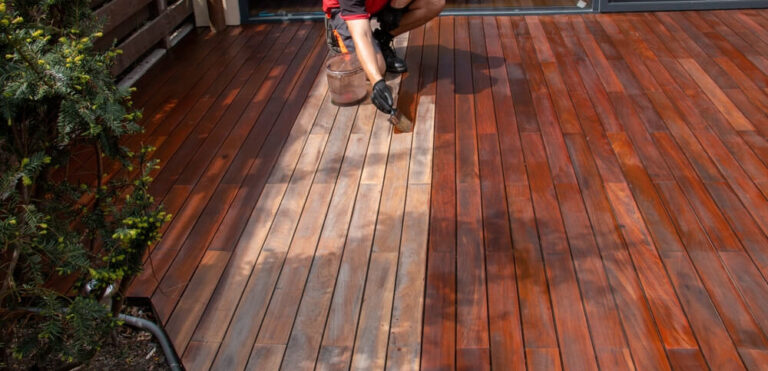Laminate Vs. Hardwood Flooring: Which Is Better Option❓

When it comes to choosing the right flooring for your home, two popular options that often come to mind are laminate and hardwood. Both of these floors have their own unique characteristics, advantages, and considerations.
Laminate and hardwood floors differ in their composition, appearance, installation, maintenance, cleaning, durability, comfort, life span, resale value, and many other factors.
After performing extensive research, we came up with this article. This blog post contains major differences between laminate and hardwood flooring to help you make an informed decision for your space. By understanding the key distinctions between laminate and hardwood, you can select the flooring option that best suits your needs and preferences.
Laminate Flooring Versus Hardwood: Key Differences
Before proceeding into details, we have compared laminate and hardwood floors to give you a quick overview. Have a look at the basic differences:
| Factors | Laminate Flooring | Hardwood Flooring |
| Construction | Multiple layers, typically with a fiberboard core and photographic layer | Solid wood planks cut from a single piece of timber |
| Durability | Resistant to scratches, fading, and stains; susceptible to moisture damage | Highly durable and long-lasting |
| Refinishing | Cannot be refinished | Can be sanded and refinished multiple times |
| Appearance | Mimics the look of natural materials; wide range of colors and patterns | Authentic beauty of natural wood with unique grain patterns |
| Maintenance | Minimal maintenance required; regular sweeping or damp mopping | Regular sweeping or dry mopping; periodic deep cleaning and polishing |
| Cost | Generally more budget-friendly | Higher initial cost; considered a higher-end option |
| Installation | Floating installation method; easier for DIY | Professional installation recommended |
| Lifespan | Long-lasting, but cannot be refinished | Longevity with the ability to be sanded and refinished |
Differences Between Laminate And Hardwood Floors
Until now, you must have a basic understanding of both the floors. But this is not enough if you are planning to make a purchase for your home. Make sure to know every bit of information about these flooring. Given below are dissimilarities between both of these floors:
1. Composition
Composition is a key factor that sets hardwood and laminate flooring apart.

Hardwood flooring is crafted from real wood. It is typically made from a single piece of solid wood, cut into planks of various lengths, widths, and thicknesses. Common wood species used for hardwood flooring include oak, maple, cherry, walnut, and hickory.
On the other hand, laminate flooring is a synthetic product designed to mimic the appearance of hardwood. It is composed of multiple layers fused. The core layer is usually made of high- or medium-density fiberboard (MDF), which provides stability and strength to the flooring. Above the core layer is a photographic layer, also known as the design layer. Finally, a transparent wear layer is applied on top to protect the flooring from scratches, stains, and fading.
2. Appearance
Laminate flooring contains a printed layer with a photographic image of wood grain covered by a protective wear layer. It replicates the appearance of natural materials, including hardwood, stone, and tile to some extent. It may lack the depth, texture, and natural variations of real wood. It is available in a wide range of colors, patterns, and textures.
Hardwood flooring has a timeless and elegant appearance that adds warmth and character, a sense of luxury and sophistication to any space. It showcases the natural beauty of real wood, with variations in grain patterns, knots, and color tones. Each plank is unique, offering an authentic look. You can lay hardwood floors differently in different rooms for a variety in design.
3. Installation

Hardwood flooring installation typically involves more complex and time-consuming processes. It is installed using various methods, including nail-down, glue-down, or floating installations, depending on the type of hardwood and the subfloor.
On the other hand, laminate flooring is designed to be more DIY-friendly and easier to install. It often features a click-and-lock or tongue-and-groove system, allowing the planks to be easily connected and secured. It is installed as a floating floor which means they are not attached to the subfloor and can be installed directly over an existing floor or underlayment.
While both flooring installations require some level of skill and precision, laminate flooring is generally considered to be more user-friendly for those who prefer to tackle the installation themselves. However, it’s important to note that professional installation is still recommended for achieving the best results and ensuring the longevity of the flooring.
4. Maintenance and Cleaning
Laminate Flooring requires minimal maintenance due to its durable and stain-resistant properties. Regular sweeping or vacuuming, along with occasional damp mopping with bleach, is usually sufficient. Avoid excessive moisture, as water can seep into the seams and cause damage to the laminate flooring. It is more resistant to stains and scratches, making it easier to maintain. It is more resistant to stains and scratches, making it easier to maintain.
Hardwood Flooring needs regular sweeping, vacuuming, or dry mopping to remove dirt, dust, and debris. When cleaning them, avoid excessive moisture or harsh chemicals that can damage the wood. A damp mop or specialized wood floor cleaner should be used for gentle cleaning. It is suggested to immediately wipe up any spills to prevent moisture absorption. They periodically need deep cleaning, refinishing, and polishing to maintain its luster.
Overall, hardwood flooring requires more specialized care and maintenance to preserve its natural beauty and durability. While laminate flooring offers easier maintenance and cleaning options.
5. Durability

Laminate Flooring is constructed with multiple layers of synthetic materials fused together. While it is designed to be durable, it is generally not as resilient as hardwood. It is known for its resistance to scratches, fading, and cannot be refinished again and again. Its wear layer provides protection against everyday wear and tear. However, it is more susceptible to moisture damage and damage from heavy impacts or sharp objects. Laminate flooring typically has a shorter lifespan compared to hardwood and may need to be replaced sooner, especially in high-traffic areas.
Hardwood Flooring offers exceptional durability and longevity. It is made from solid wood, which provides a strong and resilient surface. It can withstand heavy foot traffic, scratches, and dent. They have the potential to last for decades with proper care and maintenance. It can be sanded and refinished multiple times, allowing you to restore the surface and remove minor imperfections. It is prone to scratching and may require regular maintenance to preserve its appearance.
To summarize, hardwood flooring is renowned for its ability to withstand the test of time. Laminate flooring offers decent durability but may not be as resistant to impacts and wear as hardwood.
6. Water & Heat Resistance
Hardwood flooring is not water-resistant, sensitive to changes in humidity and temperature, and susceptible to moisture damage resulting in warping, swelling, or cupping. It is not recommended to install hardwood flooring in areas with high humidity or moisture, such as bathrooms or basements.
On the other hand, laminate flooring is designed to be more water-resistant than hardwood. It is constructed with a moisture-resistant core, typically made of high-density fiberboard (HDF) or plywood, which helps to protect it from water damage. Its wear layer provides resistance to spills and moisture, making them suitable for areas with higher moisture levels, such as kitchens and bathrooms. However, it is important to note that laminate flooring is not waterproof, and excessive water exposure can still cause damage over time.
In terms of heat resistance, hardwood flooring performs better than laminate. Hardwood is a natural insulator and retains heat well, making it a suitable choice for underfloor heating systems. Laminate flooring can be affected by direct heat sources such as radiant heating systems.
7. Comfort & sound

Hardwood flooring has a natural warmth and comfort underfoot. It provides a solid and stable surface that feels pleasant to walk on. It may not offer as much cushioning compared to other flooring materials. Additionally, hardwood floors can transmit more sound, such as footsteps, creaking at night, or echoes, which can impact the overall acoustic environment of a room.
Laminate flooring can be more comfortable to walk on due to its softer underlayment or padding layer. This provides a slight cushioning effect and can reduce foot fatigue, especially in areas with high foot traffic. It also has the advantage of reducing sound transmission compared to hardwood floors. The construction of laminate, including the underlayment, helps to absorb and dampen sound, resulting in a quieter environment.
It is important to note that the comfort and sound qualities of both hardwood and laminate flooring can be enhanced with the use of rugs or carpeting. Adding area rugs or carpets can provide additional cushioning and insulation, making the floor more comfortable to walk on and reducing sound transmission even further.
8. Cost comparison and considerations
Laminate Flooring is generally more budget-friendly compared to hardwood. Its prices vary based on the quality, design, and thickness of the laminate. Its installation cost may be lower, as laminate flooring often utilizes a floating installation method.
Hardwood Flooring is considered a higher-end flooring option, resulting in a higher initial cost. Its prices vary depending on the wood species, grade, and finish. Its Installation costs can be higher, particularly for solid hardwood, which requires professional installation.
9. Lifespan

With proper care and maintenance, hardwood floors can last for decades, and in some cases, even a lifetime. Over time, hardwood floors can be refinished to restore their original beauty, further extending their lifespan. The lifespan of hardwood flooring can vary depending on factors such as the wood species, the quality of installation, and the level of foot traffic it receives.
Laminate flooring has a shorter lifespan compared to hardwood. On average, laminate floors can last around 10 to 20 years, depending on the quality of the product and the level of maintenance. Unlike hardwood, laminate flooring cannot be refinished. Once it starts to show signs of wear and damage, it typically needs to be replaced.
10. Resale value
Hardwood flooring is highly regarded in the real estate market and is often seen as a desirable feature in homes. It is considered a premium flooring option that adds value to a property. Its natural beauty and longer lifespan positively impacts the resale value of a home.
On the other hand, laminate flooring typically has a lower resale value compared to hardwood because it mimics the look of hardwood. It is generally considered a more affordable and less premium option. Potential buyers may view laminate as a temporary or lower-quality flooring choice, which can impact the perceived value of the property.
Pros & Cons Of Laminate Vs. Hardwood Flooring
Given below is the precise list of advantages and disadvantages of laminate and hardwood floors:

Pros of Laminate Flooring
Have a look at the advantages of laminate floors:
- Wide range of design options, including realistic wood and tile looks
- More affordable compared to hardwood flooring
- Easy installation with click-and-lock or glue-down systems
- Resistant to scratches, fading, and stains
- Low maintenance and easy to clean
- Can be installed in moisture-prone areas with proper precautions
- Suitable for DIY installation
- Can be used with underfloor heating systems
Cons of Laminate Flooring
Given below are some of the drawbacks of the laminate floors:
- Not as durable as hardwood flooring and may need replacement after a certain period
- Difficult to repair damaged sections; often requires replacing the entire plank
- Prone to water damage if exposed to excessive moisture or standing water
- Less warmth and authenticity compared to real hardwood
- Limited refinishing options; laminate cannot be sanded and refinished like hardwood
- May produce a hollow or artificial sound underfoot
Pros of Hardwood Flooring
Let’s study the positives of hardwood flooring:
- Timeless and authentic beauty, with natural variations and rich grain patterns
- Excellent durability and longevity; can last for decades and even generations
- Can be sanded and refinished multiple times to restore its original appearance
- Adds value to the home and enhances its aesthetic appeal
- Provides warmth and a cozy atmosphere
- Wide range of wood species, finishes, and styles to choose from
- Can be repaired and refinished to address minor damage
Cons of Hardwood Flooring
Have a look at the cons of hardwood flooring:
- Generally more expensive than laminate flooring
- Requires professional installation or advanced DIY skills
- Susceptible to scratches, dents, and fading over time
- Can be affected by moisture and humidity; may require additional precautions in wet areas
- Regular maintenance and periodic refinishing are necessary to preserve its beauty
- Limited design options compared to laminate flooring
- Not recommended for below-grade installations (such as basements) due to potential moisture issues
It’s important to consider these pros and cons when choosing between laminate and hardwood flooring to find the option that best suits your needs, budget, and preferences.
Conclusion
Choosing between laminate and hardwood flooring ultimately depends on your specific needs, budget, and aesthetic preferences. Laminate flooring offers durability, affordability, and a wide range of design options, making it a popular choice for many homeowners. On the other hand, hardwood flooring provides a timeless and luxurious appeal, along with the ability to be sanded and refinished. Ultimately, both laminate and hardwood can enhance the beauty and functionality of your space, providing you with a durable and visually appealing flooring solution.







